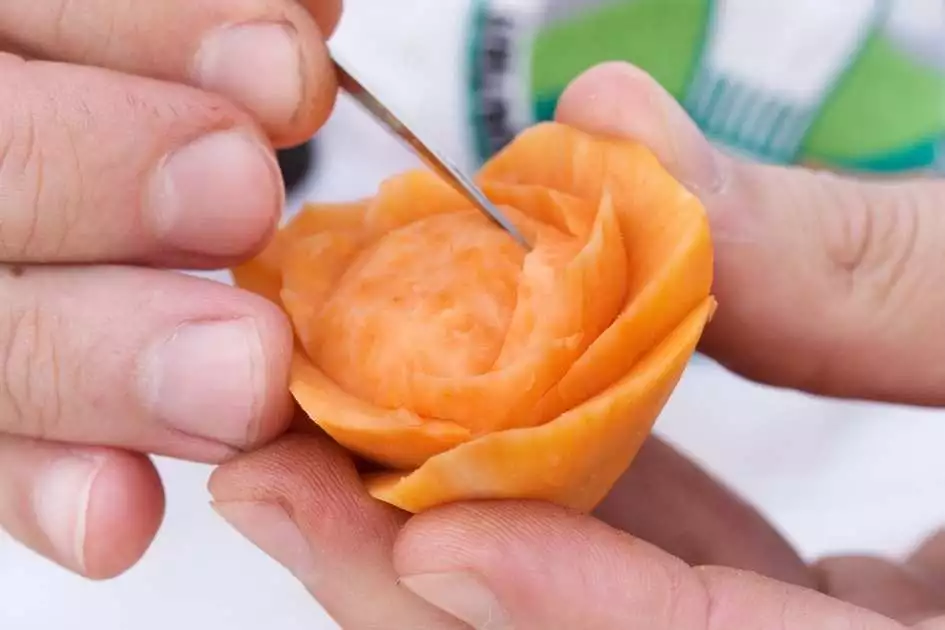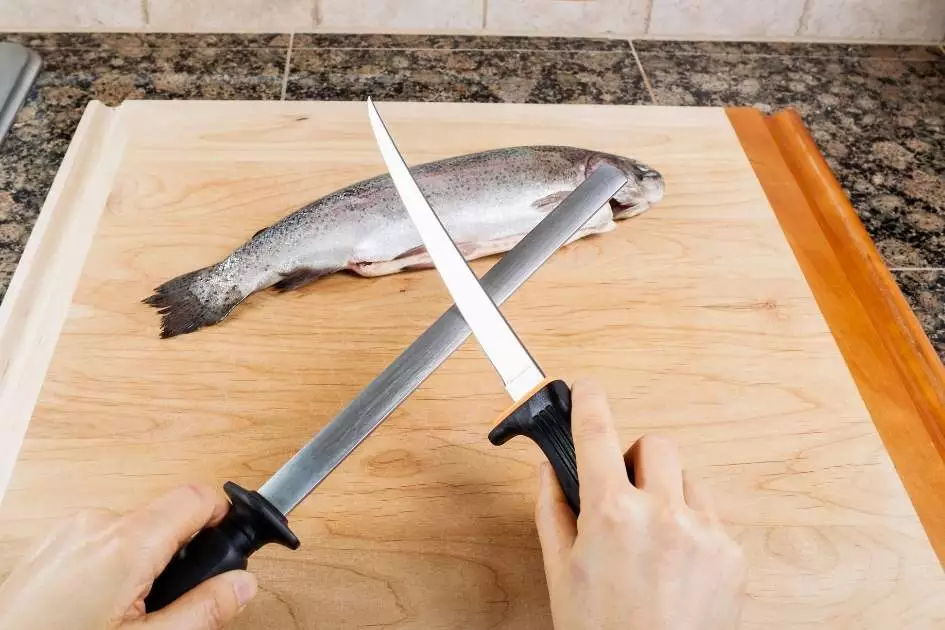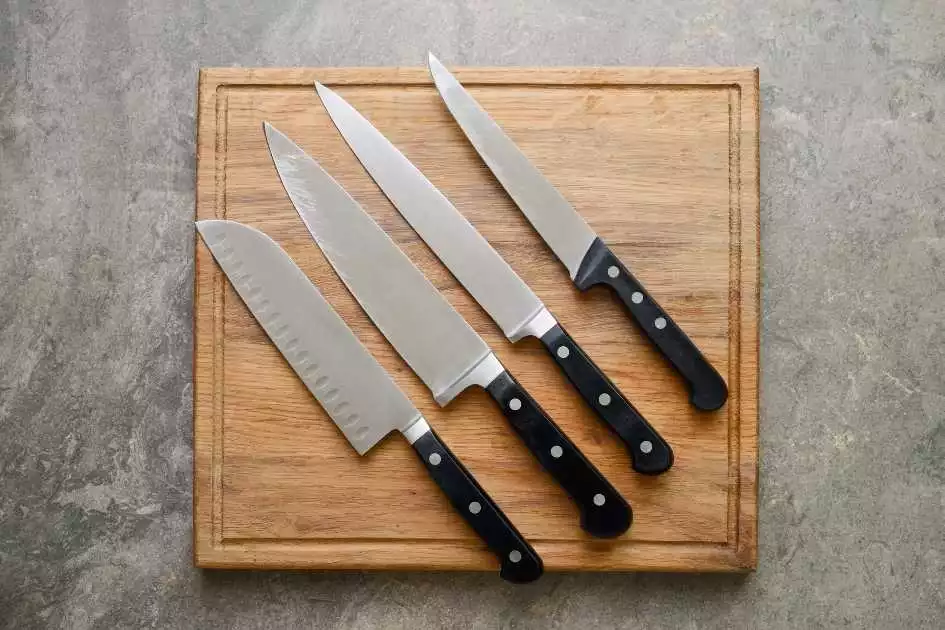There are times when you have to work more precisely in the kitchen. You think of a better tool to achieve greater results. You look around, and the only thing you can find is a simple knife.
When you want to get a more decorative cut on vegetables or cut fruits and vegetables into very thin slices, the tourne knife can come in handy. In addition, many people like to use this type of knife for peeling potatoes because it gives them more control over how much peel they take off compared to using a larger chef's knife.
What is a Tourne Knife?
A tourne knife is a small paring knife with a blunt tip and rounded corners. As the name implies, it's very specific to tourne foods. The blade is slightly curved, which makes it perfect for peeling and slicing fruits and vegetables. Because the tip of the knife is not sharp, you can use it to make decorative cuts without worrying about piercing the fruit or vegetable.
For example, if you wanted to cut carrots into thin rounds, this would be the ideal tool. Additionally, many people find that potatoes are easier to peel with a tourne knife than with a standard chef's or paring knife because of its shape.
What Is a Tourne Knife Used For?
This versatile kitchen tool can be used for a variety of tasks. Common uses for a tourne knife include:
Carving
You don't have to be a sculptor, us either. But honestly, you feel like one when you start carving with a tourne knife. The unique shape of this knife lets you carve even the most detailed designs. This is why it's often used for carving fruits and vegetables into beautiful pieces of art.
When you are carving a vegetable or fruit where you are maneuvering around a lot of small details, it'd be more than challenging with a large chef knife. However, a tourne knife can help you make precise cuts without worrying about slicing your fingers in the process. As you carve, the tourne knife will hug the contours of the vegetable, allowing you to make clean cuts.
Shaping vegetables, fruits, and garnishes
When you are planning for an entertaining event or dinner party, you may want to take your food presentation up a notch. Before you eat fruits, why not have fun first? A tourne knife can be used to create beautiful and intricate shapes out of vegetables, fruits, and even cheese.
You can make edible art pieces by carving melons, pineapples, cucumbers, and other fruits and veggies into unique shapes like flowers or swans, as well as some fancy patterns on the surface before serving them to your guests. Fluted mushrooms, accordion-cut potatoes, and flower carvings in lemons or oranges are just a few ideas of what you can do with some practice.
Shelling nuts
This can also be tricky, but a tourne knife can help you get into the nooks and crannies to release the nut from its shell. Maybe you want to keep the shell intact, like when you’re making a holiday decoration. In that case, use the tourne knife to make small scores around the circumference of the nut before cracking it open by hand.
Another bonus of using a tourne knife for this is that it will not damage the nutmeat.
Removing rinds and peels
When you’re working with potatoes, like when making these roasted potatoes with rosemary and sea salt, the tourne knife is perfect for getting into the nooks and crannies to remove any rinds or peels. It will also help you make very smooth cuts as you prepare your recipe.
Just like with potatoes, the tourne knife is perfect for getting into heavy-skinned fruits and vegetables. This includes items like squash, apples, pears, and more. The slim blade will help you make smooth cuts without damaging the fruit or vegetables underneath. Just peel the outer layers of the fruit or vegetable off, leaving the fresher parts of the produce behind for juicing, cooking, or eating.
Peeling
The sharp tip and curved blade help you peel fruits and vegetables with ease. Potatoes are notoriously difficult to peel, but a tourne knife can make quick work of them. If you find yourself in need of precision when cooking, reach for your tourne knife. It’s the perfect tool for detailed work like removing seeds from cucumbers or carving Halloween pumpkins.
Peeling an apple in one long strip can also be a neat way to show off your skills. If you’re feeling extra creative, use the peel to spell out your name or a message! To get started, cut off both ends of the apple and then cut halfway through the skin lengthwise. Make small cuts from one end to another in a zig-zag pattern around the apple. Then simply peel away the skin.

How to Use Tourne Knives
When using your tourne knife, grip it like you would any other paring knife, in your dominant hand with your index finger extended along the top of the blade. For the best results, your wrist should be positioned over your knuckles and you should use a rocking motion to work through vegetables or fruits.
If you want to make decorative garnishes like roses out of thin slices of fruits or vegetables, start by slicing off thin rounds of food by holding it firmly with one hand, then curl each round into a rose shape and secure it with a toothpick if necessary.
There is also the zig-zag pattern called a "tourne" and it is the signature cut made by this type of knife. To achieve it, start by carving out a small cone from the vegetable or fruit. From there, make evenly-spaced cuts around the circumference of the cone, angling them towards the center as you go. Finally, cut off the point of the cone to create perfect tourne shapes.
Maintenance and Care
A tourne knife is extremely easy to care for since there are no crevices that need to be scrubbed clean or mechanisms that need to be oiled. Simply wash it with soap and water after each use, being careful not to cut yourself on the blade, of course. If the blade begins to dull, you can sharpen it using a honing rod or sharpening stone; either one will do the trick.
We recommend storing your tourne knife in a block or sheath to protect the blade and yourself as well. Since it's pointed and sturdy, there's always the risk of accidentally stabbing yourself or someone else if it isn't properly stored.
Final Thoughts
We like special-purpose tools that do the job, and they are even more appealing when they can do more than one thing. This is where the tourne knife shines, with its versatility and multi-functionality for both the home cook and the professional chef.
So, after you've decided on what fruit or vegetable to decorate with, and practiced your technique a few times, it's time for the real thing. Make sure all of your tools are clean and sharp before starting. Cut away any blemishes on the surface of the fruit so that you have a smooth canvas to work with; an imperfection can ruin an otherwise beautiful carving. Have fun creating edible art, and don't forget to take pictures!


